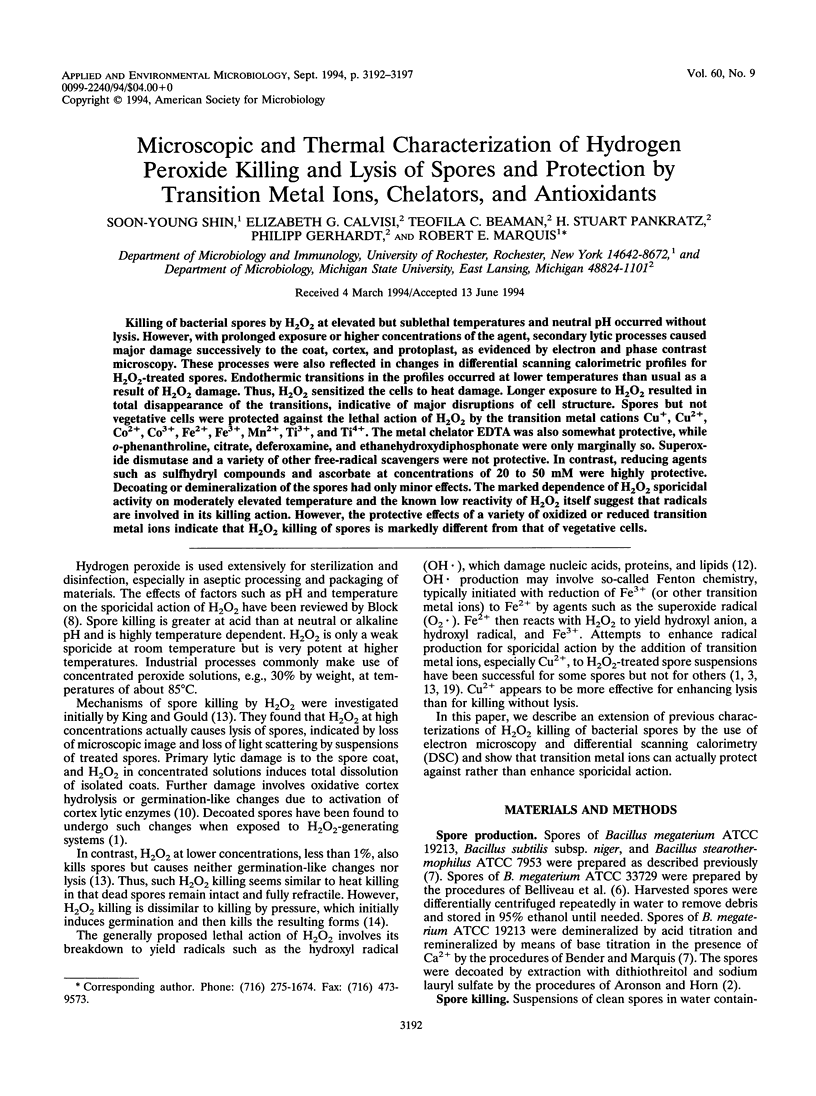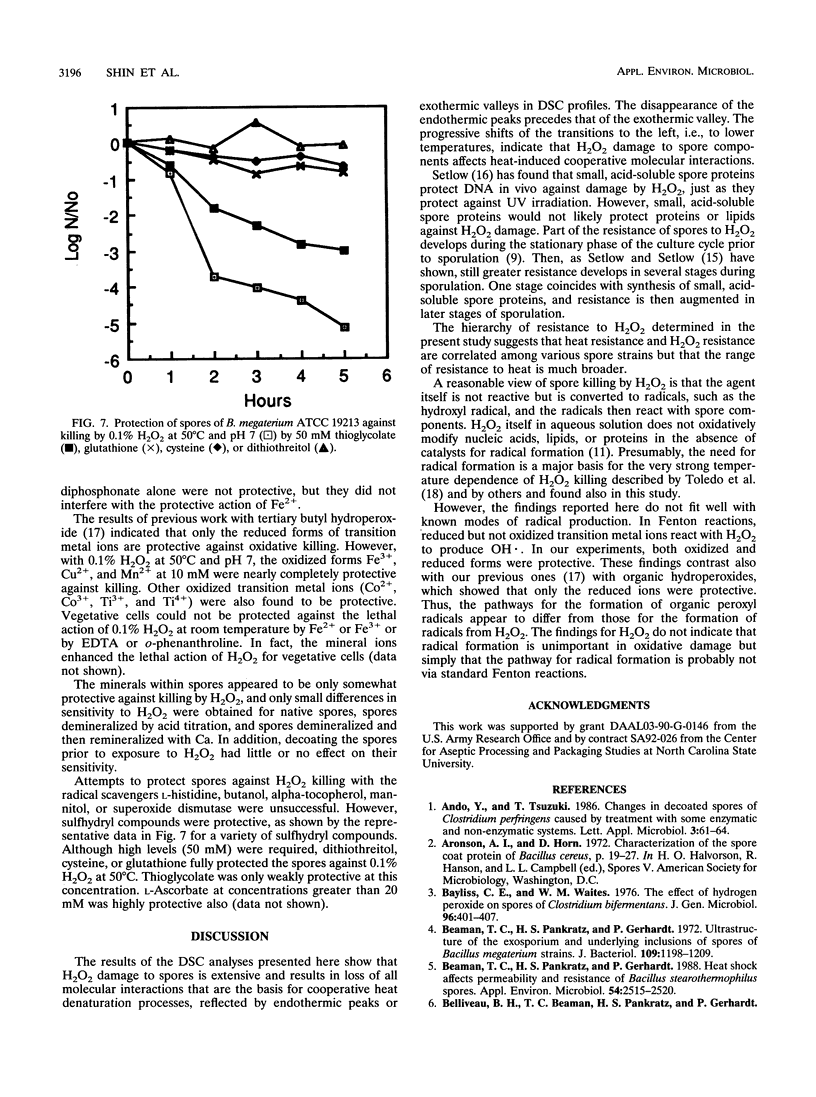Abstract
Killing of bacterial spores by H2O2 at elevated but sublethal temperatures and neutral pH occurred without lysis. However, with prolonged exposure or higher concentrations of the agent, secondary lytic processes caused major damage successively to the coat, cortex, and protoplast, as evidenced by electron and phase contrast microscopy. These processes were also reflected in changes in differential scanning calorimetric profiles for H2O2-treated spores. Endothermic transitions in the profiles occurred at lower temperatures than usual as a result of H2O2 damage. Thus, H2O2 sensitized the cells to heat damage. Longer exposure to H2O2 resulted in total disappearance of the transitions, indicative of major disruptions of cell structure. Spores but not vegetative cells were protected against the lethal action of H2O2 by the transition metal cations Cu+, Cu2+, Co2+, Co3+, Fe2+, Fe3+, Mn2+, Ti3+, and Ti4+. The metal chelator EDTA was also somewhat protective, while o-phenanthroline, citrate, deferoxamine, and ethanehydroxydiphosphonate were only marginally so. Superoxide dismutase and a variety of other free-radical scavengers were not protective. In contrast, reducing agents such as sulfhydryl compounds and ascorbate at concentrations of 20 to 50 mM were highly protective. Decoating or demineralization of the spores had only minor effects. The marked dependence of H2O2 sporicidal activity on moderately elevated temperature and the known low reactivity of H2O2 itself suggest that radicals are involved in its killing action. However, the protective effects of a variety of oxidized or reduced transition metal ions indicate that H2O2 killing of spores is markedly different from that of vegetative cells.
Full text
PDF





Images in this article
Selected References
These references are in PubMed. This may not be the complete list of references from this article.
- Bayliss C. E., Waites W. M. The effect of hydrogen peroxide on spores of Clostridium bifermentans. J Gen Microbiol. 1976 Oct;96(2):401–407. doi: 10.1099/00221287-96-2-401. [DOI] [PubMed] [Google Scholar]
- Beaman T. C., Pankratz H. S., Gerhardt P. Heat shock affects permeability and resistance of Bacillus stearothermophilus spores. Appl Environ Microbiol. 1988 Oct;54(10):2515–2520. doi: 10.1128/aem.54.10.2515-2520.1988. [DOI] [PMC free article] [PubMed] [Google Scholar]
- Beaman T. C., Pankratz H. S., Gerhardt P. Ultrastructure of the exosporium and underlying inclusions in spores of Bacillus megaterium strains. J Bacteriol. 1972 Mar;109(3):1198–1209. doi: 10.1128/jb.109.3.1198-1209.1972. [DOI] [PMC free article] [PubMed] [Google Scholar]
- Bender G. R., Marquis R. E. Spore heat resistance and specific mineralization. Appl Environ Microbiol. 1985 Dec;50(6):1414–1421. doi: 10.1128/aem.50.6.1414-1421.1985. [DOI] [PMC free article] [PubMed] [Google Scholar]
- Dowds B. C., Murphy P., McConnell D. J., Devine K. M. Relationship among oxidative stress, growth cycle, and sporulation in Bacillus subtilis. J Bacteriol. 1987 Dec;169(12):5771–5775. doi: 10.1128/jb.169.12.5771-5775.1987. [DOI] [PMC free article] [PubMed] [Google Scholar]
- Foster S. J., Johnstone K. Purification and properties of a germination-specific cortex-lytic enzyme from spores of Bacillus megaterium KM. Biochem J. 1987 Mar 1;242(2):573–579. doi: 10.1042/bj2420573. [DOI] [PMC free article] [PubMed] [Google Scholar]
- Gutteridge J. M., Quinlan G. J. Antioxidant protection against organic and inorganic oxygen radicals by normal human plasma: the important primary role for iron-binding and iron-oxidising proteins. Biochim Biophys Acta. 1993 Feb 13;1156(2):144–150. doi: 10.1016/0304-4165(93)90129-v. [DOI] [PubMed] [Google Scholar]
- Halliwell B., Gutteridge J. M. Biologically relevant metal ion-dependent hydroxyl radical generation. An update. FEBS Lett. 1992 Jul 27;307(1):108–112. doi: 10.1016/0014-5793(92)80911-y. [DOI] [PubMed] [Google Scholar]
- King W. L., Gould G. W. Lysis of bacterial spores with hydrogen peroxide. J Appl Bacteriol. 1969 Dec;32(4):481–490. doi: 10.1111/j.1365-2672.1969.tb01002.x. [DOI] [PubMed] [Google Scholar]
- Sale A. J., Gould G. W., Hamilton W. A. Inactivation of bacterial spores by hydrostatic pressure. J Gen Microbiol. 1970 Mar;60(3):323–334. doi: 10.1099/00221287-60-3-323. [DOI] [PubMed] [Google Scholar]
- Setlow B., Setlow P. Binding of small, acid-soluble spore proteins to DNA plays a significant role in the resistance of Bacillus subtilis spores to hydrogen peroxide. Appl Environ Microbiol. 1993 Oct;59(10):3418–3423. doi: 10.1128/aem.59.10.3418-3423.1993. [DOI] [PMC free article] [PubMed] [Google Scholar]
- Toledo R. T., Escher F. E., Ayres J. C. Sporicidal properties of hydrogen peroxide against food spoilage organisms. Appl Microbiol. 1973 Oct;26(4):592–597. doi: 10.1128/am.26.4.592-597.1973. [DOI] [PMC free article] [PubMed] [Google Scholar]
- Waites W. M., Bayliss C. E., King N. R., Davies A. M. The effect of transition metal ions on the resistance of bacterial spores to hydrogen peroxide and to heat. J Gen Microbiol. 1979 Jun;112(2):225–233. doi: 10.1099/00221287-112-2-225. [DOI] [PubMed] [Google Scholar]



